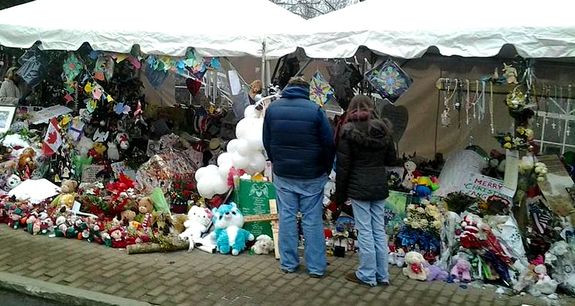
The memorial at Sandy Hook Elementary after the school shooting there last year. (Photo: Wiki Commons)
By Eric Barton
Florida Center for Investigative Reporting
It seems common these days to see stories about guns found in schools. It’s so common, in fact, that most of us probably don’t think about just how big of a problem it has become.
And that was the impetus to a project by the Miami Herald that compiled just how many guns have been found in local schools. The piece included an interactive map online that can help readers narrow in on neighborhoods and even individual schools.
The author, Herald staff writer David Smiley, answered questions by email from the Florida Center for Investigative Reporting about how the project came together — and how other media outlets can copy the idea.
FCIR: How did you get the idea for this investigation?
David Smiley: I started on the Miami-Dade schools beat at The Herald in January, just a few days after the Sandy Hook massacre and a few weeks after a 13-year-old charter school student was fatally shot by another student aboard a private bus. So there was a lot of conversation at the time about guns in schools and safety measures. And once the Florida legislative session started, and proposals to beef up security surfaced, I realized there was a lot of legitimate concern but not much information about the threat guns do or don’t pose in our schools.
FCIR: In this era of reduced newsroom staffs and fewer resources, how did you handle the reporting of this piece with your regular duties?
Smiley: I have really patient editors who understand the importance of taking time to dig deeper. We requested the first round of reports in April, but due to the time it took the get the documents most the work was done over the summer while school was out. That allowed us some down time enter information from reports into a spreadsheet and establish an interactive map for readers.
FCIR: You spent three months collecting and analyzing hundreds of police reports. What did it take to gather and analyze them?
Smiley: I wrote many, many emails to the school districts and made many, many phone calls. In the case of Miami-Dade, it just took a long time to pull, redact and review all the reports. With Broward, which uses other departments to police its schools, it took a while just to make sure they kept the information.
Once the districts handed over the reports, entering the information into a spreadsheet took about three or four days. That was important because it allowed us to sort the data to find out which schools had more of a problem, where the guns came from, why they were brought to school, etc.
FCIR: Did it seem like school administrators were aware of how widespread guns are in school, or was your reporting eye opening for them?
Smiley: I think generally they already knew what the reports and numbers showed. They had to compile the reports in order to send them, so they’d already seen everything I received. They also report gun incidents to the state each year. It’s the parents, communities and students who I think have been unaware.
FCIR: This is a story that could be repeated by newspapers elsewhere. Any advice you’d offer to another reporter looking to take this on?
Smiley: Know your public records laws. Have persistence. Document all your interactions with records custodians. And focus your interests as much as you can before you begin requesting records. It will probably save you time and money.
